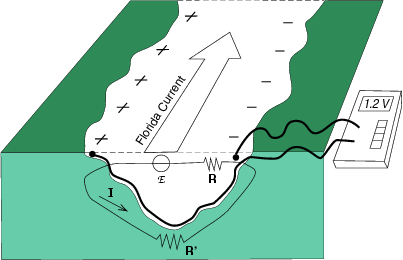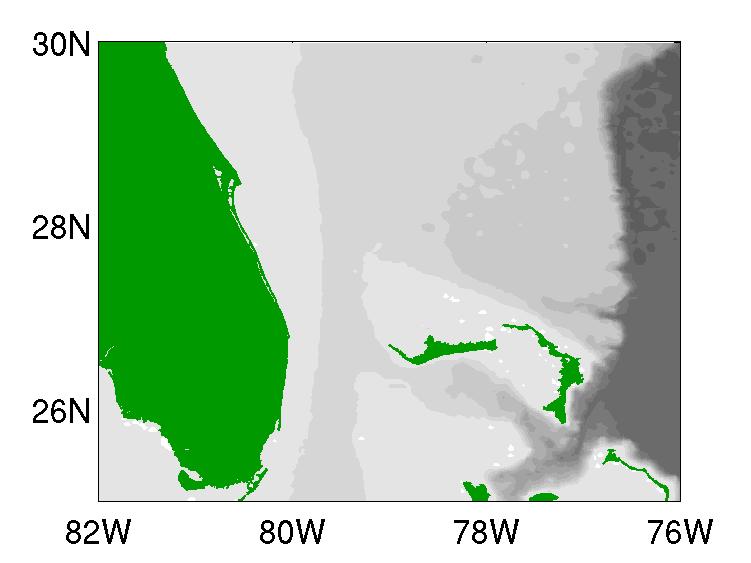Florida Straits Cable - Background
Basics of Cable physics:
When electrically charged particles move through a magnetic field an electrical field is developed that is perpendicular to the movement of the particles. This has been known since the pioneering experiments of James Maxwell in the mid-1800s. The same physics dictate that when ions in seawater are advected by ocean currents through the magnetic field of the Earth, an electric field is produced perpendicular to the direction of the water motion. Because seawater is a conductive media, these electric fields "short-out" in the vertical, yielding a single electric field corresponding to the vertically averaged horizontal flow (with a minor vertical weighting effect due to small conductivity changes at different depths). Submarine cables provide a means for measuring these "motionally-induced" voltages in the ocean. Using the voltages induced on the cables, the full-water-column transports across the cable can be estimated.
...
The initial demonstration of the ability of a submarine
cable to measure transport was made by Stommel in a study of the
transport between Key West and Cuba [Stommel, 1948; 1957; 1959; 1961]. More recently, the
conversion of the voltage measurements to transport and the errors
associated with this conversion, such as geomagnetic fluctuations,
temperature, and meandering effects, have been discussed in Larsen,
1992.
The voltage signal on a submarine cable will be a blend of the
motionally induced signal due to oceanic transport variations with
other fluctuations of the magnetic field of the Earth, which can be
forced by both internal changes in the planetary core as well as by
external fluctuations due to processes such as solar storms. In
order to estimate the oceanic transport fluctuations using the cable it
is necessary to remove, as best as possible, the voltage variations
that are due to fluctuations of the Earths magnetic field. This
is a complex procedure, as the externally-forced magnetic field
variations (primarily solar) dominate the observed voltage signals at
periods of less than a few days [Luther et al., 1991], while at very
long periods, centuries and longer, magnetic field fluctuations due to
internal changes within the Earth dominate the voltage signals.
In order to remove the voltage fluctuations that are not oceanic in
nature, magnetic field measurements from the nearest magnetic
observatories are used to estimate the magnetic field at the site of
the cable, and transfer functions are estimated to determine the
voltage signal associated with the observed magnetic field
variations. The United States Geological Survey maintains a
number of magnetic field observatories at a wide range of sites
throughout the US and its territories through their geomagnetism program. To the
extent that the signals at the observatories
are represented in the voltage time series from the cable, this should
allow for the removal of the non-ocean related voltage changes.
In practice, the high frequency variations are not generally well
enough correlated between the cables and the observatories to
remove the high frequency signals from the cable with a high level of
precision. As a result, the voltage values are commonly low-pass
filtered to remove these non-ocean signals and then the voltage is
averaged to provide daily averages. (The tide signal must also be
removed prior to averaging to avoid aliasing any of the tide signal
into the daily mean values.)
An additional part of the conversion from voltage to transport involves
the use of in situ estimates of the ocean transport which are obtained
using either velocity profile (Lowered Acoustic Doppler Current
Profiler) or vertical mean velocity estimates (from GPS-equipped floats
called Dropsondes). Historically the Pegasus velocity
profiling system was also used for calibration of submarine cables, but
due to economic reasons that system is rarely utilized these
days. The in situ transport estimates are compared to the cable
estimates and are used to calibrate the cable-derived transports,
taking into account factors such as the length of the cable and the
conductivity of the sediments surrounding the cable.
Application to the Florida Current:
Since 1982 cables have been used to measure the transport of the Florida Current between Florida and the Bahamas near 27°N. Geomagnetic data from the San Juan, Puerto Rico, Fredricksburg, Virginia and Stennis, Mississippi magnetic observatories have been used during different segments of this time period to remove the magnetic field fluctuations from the voltage data.
Details of the history of cable measurements in the Florida Current can be found in Larsen, 1992. Most recently, a cable between West Palm Beach, FL and Eight Mile Rock, Grand Bahamas Island has been used. These measurements continued until October 1998, when this cable was retired from telephone service and replaced by a cable between Vero Beach, FL and Eight Mile Rock, Grand Bahamas Island. When the first cable was retired, it was grounded at West Palm Beach with the expectation that voltages could be recorded only at the other end.
...Technical difficulties in the retirement of the cable and funding problems led to the delay in instrumentation of this cable until March of 2000, resulting in a 17 month gap in the time series. A range of instrumental problems and cable difficulties have further delayed the reintroduction of high-quality calibrated cable measurements in the Florida Current, however most of these problems have now been solved and good quality voltages have been recorded by a system at Eight Mile Rock since October 2003 (there is good reason to hope some of the time period from 2000 to 2003 will be recoverable with additional work in the near future). An additional two month gap in the time series during September-October 2004; this resulted due to the destruction of our recording equipment by the combined forces of Hurricanes Frances and Jeanne during August and September 2004. New recording equipment was put in place in late October 2004, and voltage recording has been consistent since that time.
In the future it should also be possible to record voltages on the new active fiber optic cable using the insulated copper shield that is grounded at Eight Mile Rock, providing a second measurement both as a quality control and as a backup for future cable problems. Therefore, low cost voltage measurements of the Florida Current should be able to continue for many years.
MORE LESS
